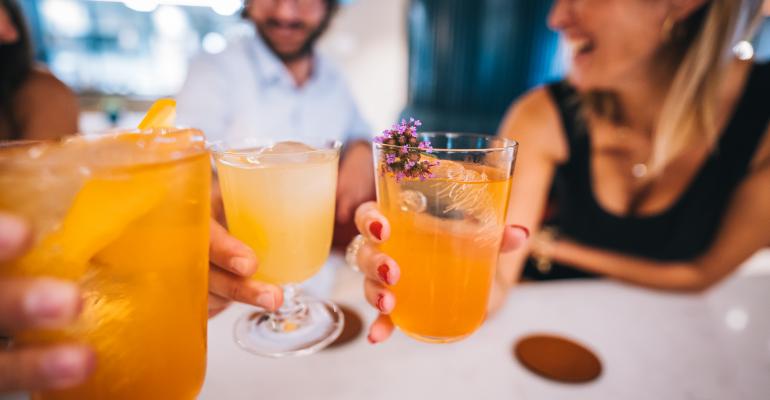Sponsored by Monin®
Satisfying the insatiable consumer appetite for what’s new and exciting is key to a successful beverage operation. Trends to watch include the rise of functional, plant-based beverages, the increasing demand for flavorful, sophisticated low-and no-alcohol drinks and the evolution coffeehouse favorites like boba tea and Thai tea into cocktail platforms.
Plant-based and functional
Better-for-you beverages—including probiotic drinks and immune-boosting beverages with plant-sourced ingredients such as elderberry, ginger, turmeric, oats, herbs and flowers—have been gaining momentum in the foodservice and retail spheres. Consumers increasingly choose them for functional benefits such as boosting energy, enhancing the immune system, promoting gut health, reducing stress and improving mental function. The latter is especially on trend today.
In fact, Datassential research shows that more than half of consumers overall and 66 percent of millennials are extremely or very likely to purchase foods that support mental well-being. “I don't think it's any surprise now after the pandemic and all the anxiety that consumers have experienced that we see a lot of them really gravitating towards foods that speak to their mind health,” said Datassential trendologist Mike Kostyo, presenting in the Datassential 2022 Trends Webinar.
Healthful twists
Against this backdrop, plant-derived ingredients are go-tos for operators serving patrons mindful of wellness yet eager for enjoyment.
At Dirty Habit, a restaurant-bar in the Kimpton Hotel Monaco in Washington, D.C., fresh fruits and vegetables, tea, herbs, flowers, syrups and infusions shine in both cocktails and zero-proof drinks.
“People are looking for more of a healthful twist on their libations today,” says Ashtyn Harris, one of the lead bartenders at Dirty Habit.
In the house cocktail Can’t Beet Me, a base of thyme-infused beet juice is married with bourbon, elderflower liqueur and citrus-flavored vermouth. “Beet juice might not be the first match for bourbon that comes to mind,” says Harris. “But infused with thyme it pairs very well with the spiciness of the bourbon.”
Another house specialty, Rosé Cheeks, taps a reduction of fresh rosemary and cranberry to add aroma, flavor and a blush to a libation with a backbone of gin, raspberry brandy and dry rosé cider.
Don’t Be a Grinch is a colorful cocktail that takes a nod from boba tea, a mixture of brewed tea, sweetener, juices, fruits and soft and chewy tapioca pearls, or boba. A Taiwanese import, boba tea is ostensibly a nonalcoholic coffeehouse drink favored by youthful consumers, akin to Thai tea and milk tea. But in this case it is an adult beverage, featuring soy matcha tea, lemongrass syrup and persimmon spiked with ginger liqueur and green tea shochu, presented in a Collins glass with a wide straw for slurping up the boba.
Boozing down
A growing number of restaurant and bar customers who drink alcoholic beverages are now choosing alcohol-free or reduced-alcohol libations from time to time, particularly when there are appealing options on the menu.
International food and restaurant consultants Baum + Whiteman dub this moderate behavior “boozing down” in their trends forecast for 2022. They say it is a reversal of the boozy indulgence that spiked among consumers during lockdown—driven in part by “more mindful eating and drinking” attitudes after COVID. “Interestingly, more than half of the people who drink the low-alcohol stuff alternate with full-strength drinks,” add Baum + Whiteman.
At Dirty Habit, Harris has developed alcohol-free signatures for patrons on hiatus from hard stuff. An example is the popular Secret Garden, which combines nonalcoholic spirits with essences of peas, herbs and hops with basil-flavored simple syrup and lemon juice. It comes in a stylish up glass with a partly sugared rim.
Another hit is Berry Spicy, a combo of muddled blackberries, lime juice and simple syrup over crushed ice, finished with a float of jalapeño water. The latter is made by steeping sliced jalapeños in hot water and then blending and straining the mixture. “It has a nice little kick to it,” Harris says, as well as a green hue that contrasts with the blackberry mixture.
Harris advises operators crafting zero-proof signatures to emphasize vivid flavor profiles in the absence of alcohol. That is an argument for further experimentation at the bar with house-made concoctions as well as labor-sparing prepared syrups, purees and flavor concentrates.
In today’s challenging business climate, it is essential to seize business opportunities when they come. The prospects appear bright for continued momentum in functional, plant-based beverages, low- and no-alcohol signature drinks and colorful, tropical specialties.





